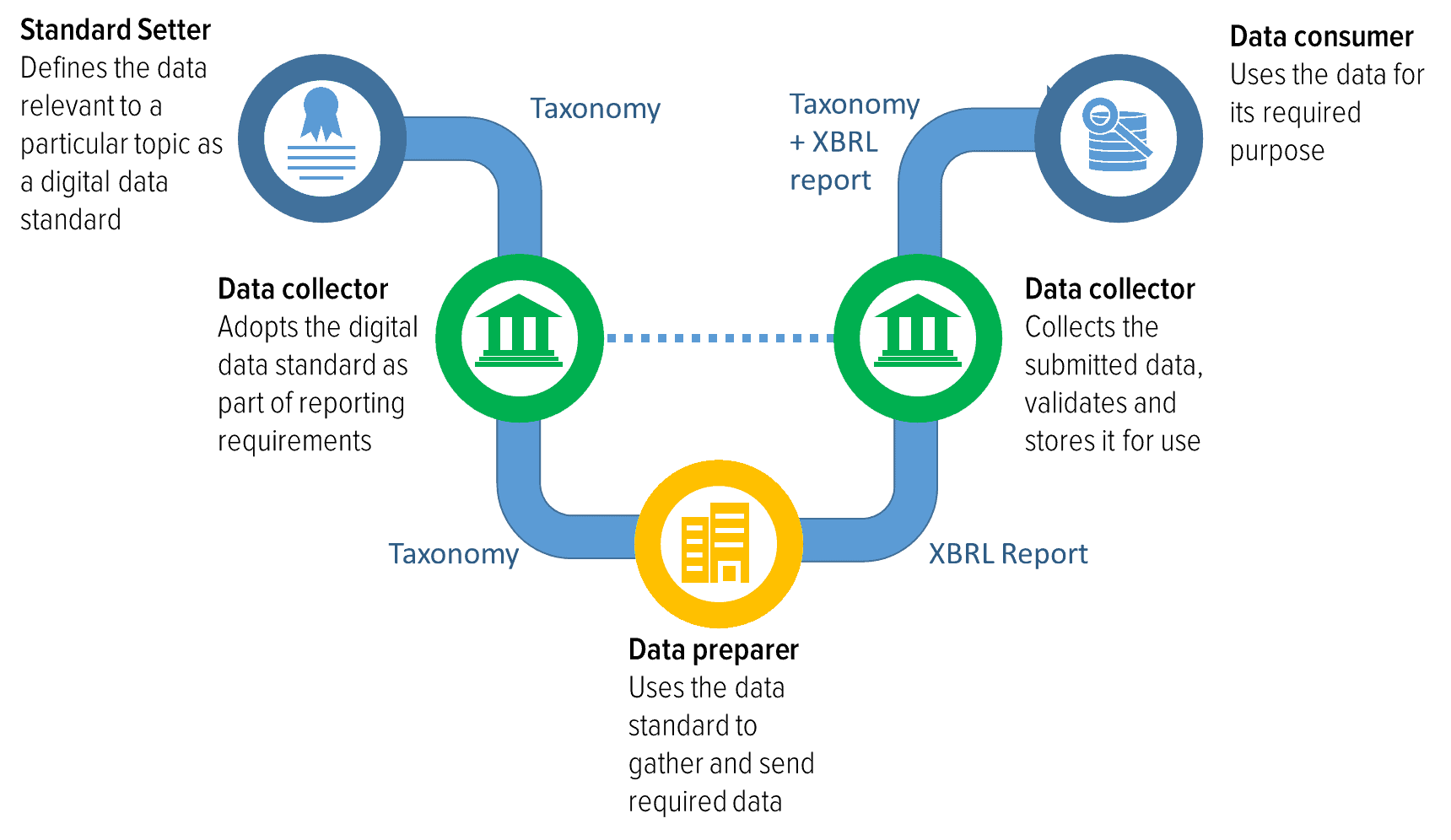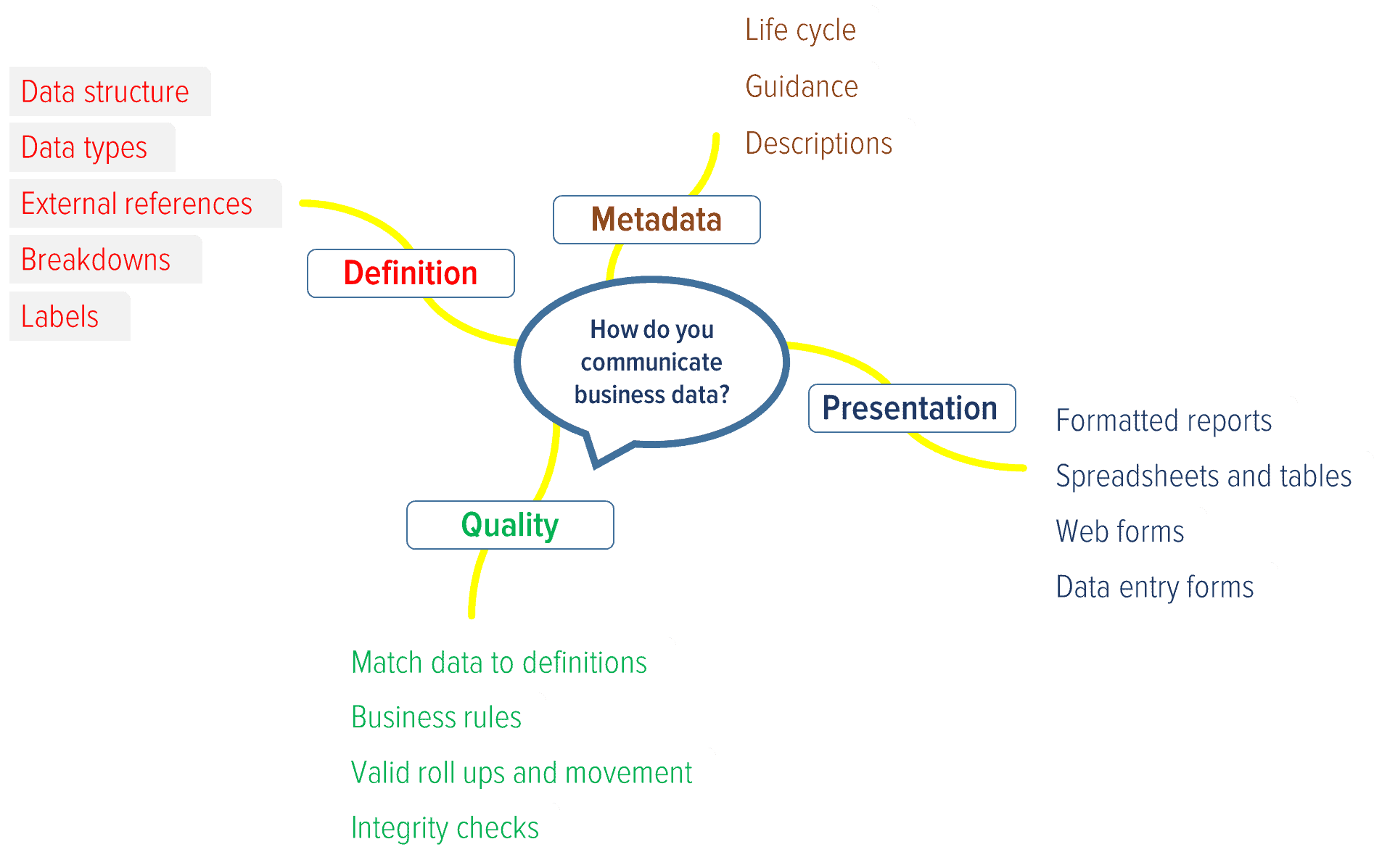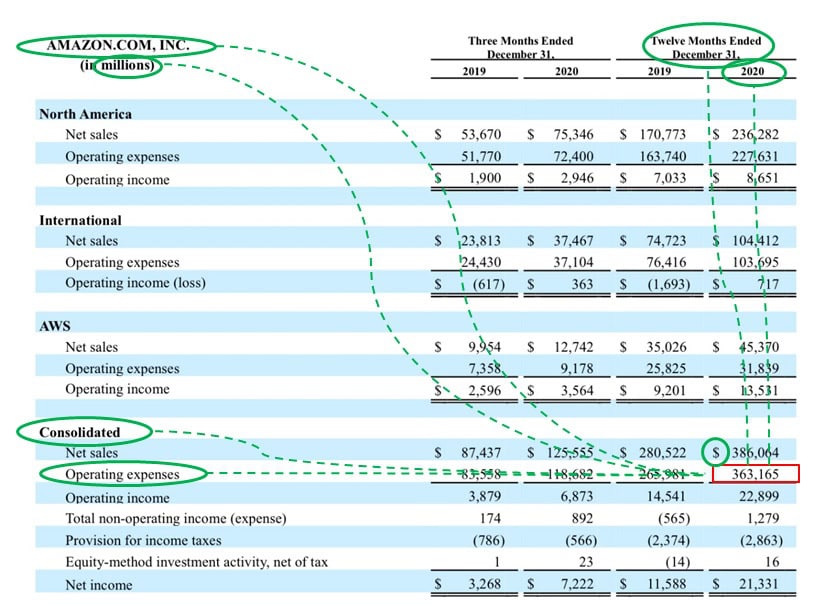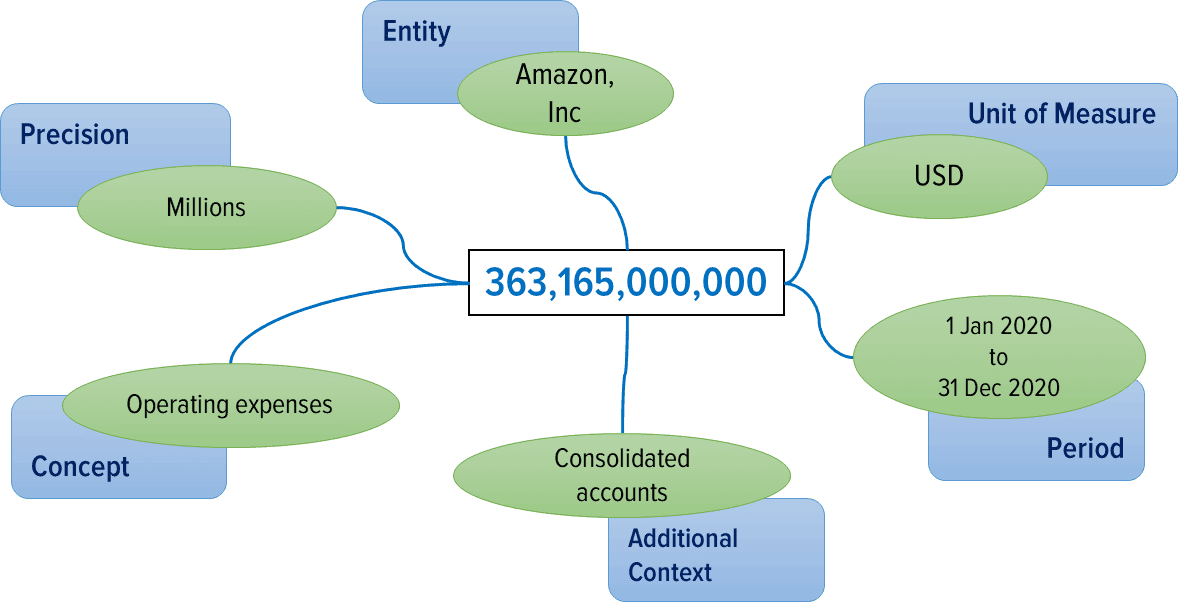What is XBRL? A Complete Guide
to XBRL Reporting, Format and Filing
Open and free standard for business reporting
XBRL is an international digital standard for business financial reporting to regulators, governments and registries, used in more than 50 countries. Its design enables communication of many types of high-quality, universally-understood, business data and metadata between organisations. XBRL is open and free to use so that it meets national and international transparency and openness requirements.
What is XBRL?
XBRL (eXtensible Business Reporting Language) is the global standard for digital business reporting, enabling seamless data exchange and compliance around the world for various sectors.
Here’s exactly what is does:
- Describes and Captures Structured Data: XBRL taxonomies define data structures, ensuring consistency across systems.
- Facilitates Data Exchange: XBRL reports package data for easy sharing between organisations and regulators.
- Ensures Accuracy: XBRL software validates data and all data explicitly refers to the XBRL taxonomy, enabling reliable interpretation by humans and machines.
- Replaces Outdated Formats: Used worldwide for financial, tax, and regulatory reporting, XBRL outperforms Excel and PDF with millions of reports created annually.
Open and Free Standard for Business Reporting
The features of XBRL solve the problems of communicating complex business data from one system or organisation to another. It is used widely with national XBRL data programmes that cover annual financial reports, tax reporting and reporting of prudential, statistical and other regulatory data all around the world.
XBRL Reporting as we know it today is primarily based on the XBRL 2.1 specification, published in its current form (as a “Recommendation”) on 31st December 2003. Since then, XBRL International has led the evolution of the standard to meet a wide variety of needs, with members around the world contributing to its development.
CoreFiling has taken a leading role as global pioneers of developing the standard, keeping it fresh and relevant to the needs of business data collectors and providers.
We’re committed to improving reporting everywhere.
Transform Your Business Reporting with XBRL Experts
XBRL Reporting Programmes
A typical XBRL implementation supports a business-to-government data collection programme, as shown below. The XBRL taxonomy and XBRL report work together to communicate data in a standardised way so that it is understood by all parties. The link between them means XBRL data has high-integrity, meaning data analysts and large language models can match data to unambiguous, detailed definitions of what it means.

It is normal for each role to be played by a different organisational stakeholder. We can see this by looking at some live filing programmes.

The variability of the stakeholders and their specific needs have driven the XBRL standards to provide a multitude of features. These features come together in the XBRL Standard to solve the problem of communicating business data.

Significant features will typically have their own specification, which describes the rules and syntax required to use the feature in a standardised way that any compliant XBRL software can understand.
- How to describe the dimensional model -> XBRL 2.1 and XBRL Dimensions 1.0 specifications
- How to display data in a spreadsheet -> Table Linkbase specification
- How to define and execute business data rules -> XBRL Formula specification
- How to create an XBRL report that looks like a traditional business report -> Inline XBRL specification
XBRL International Inc. (XII) governs the standard to oversee its development and provide authoritative support for users. Active members of XII (such as CoreFiling) participate in working groups, boards and task forces to carry out the work required. XII provides formal certification to XBRL products that meet the specifications so they can be trusted by government agencies.
The Design of XBRL
Looking at the original use case for XBRL we can gain a comprehensive understanding of its foundation:

If we look at the “363,165” figure in this table, typical of what you would find in corporate filings, we are able to obtain a good understanding of what this figure represents. This financial reporting format has been refined and perfected over time so it is informative and easy to digest.
Reading this report relies on human intuition and learning and, for a computer, even in the era of AI, we need to be more explicit to ensure a proper understanding of the source documents. XBRL’s design centres on the idea of a “standalone fact”, that is, a number that can be fully understood on its own.
A representation of a standalone fact in an XBRL report is below. Each and every useful piece of context about the figure is explicitly attached. This makes computer processing of the business data easier and more consistent.

The digital data standard, in this case the US GAAP taxonomy, contains even more information to ensure the fact is unambiguous and can be understood and used properly. If we look at the taxonomy, we can see that:
- The value represents a monetary amount (as opposed to, for example, percentage, text or date content)
- “Operating expenses” are defined in the external reference: IAS 1, 2022-03-24, Paragraph 85
- “Consolidated accounts” is selected instead of alternatives parts of the breakdown such as “Operating segment”
XBRL vs. Alternatives
Every file format and data exchange technology has its own strengths. In the table below, we contrast XBRL with a common alternative, XML, to demonstrate particular strong points of XBRL.
| Characteristic | XML | XBRL |
| Data quality | Basic syntax checks are included, business rules are documented only and must be implemented. | Several layers of quality checks runnable by standards-based processors are built in. |
| Viewing data | Relies on custom code to display data to the user. | How the data should be viewed is built in to the standard. Inline XBRL allows freeform, richly designed layouts. |
| Communication | XML schema must be accompanied by documentation such as message implementation guides and data dictionaries. | A single XBRL taxonomy package with standardised content contains everything required to create reports. |
| Software support | Low level, developer support requires custom applications to make usable. | Standards-based business software is available for use with any data set. |
| Data is long-lived | As documentation, schema and processing change, old XML files become an unreliable source. | Explicitly tied to a single taxonomy, XBRL documents retain their integrity over a long period. |
| Data structures | XML uses a hierarchical data structure that is limited in its application to business data. | XBRL supports the dimensional and hierarchical structures commonly found in business data. |
| Fidelity of information | Data items usually missing key information such as precision and time-based information. | Captures every aspect of a piece of business data that is needed for proper analysis. |
From the above table, we can see the strengths of XBRL in providing a solution for many business requirements entirely within a single standard.
It is common to see XBRL, XML and other technologies used side-by-side to meet different data needs. Transactional messages such as updating contact details are well suited to XML, whereas XBRL delivers long-lived, unambiguous, highly-functional, reporting to create documents of record. Once data gets more complex and multiple parties are involved, XBRL cannot be beaten for its flexibility and quality.
How CoreFiling use XBRL
At CoreFiling, our approach has always been to implement the specifications first and then build integration layers and business applications on top of this. A major benefit to this approach is that it leads to extremely robust solutions that guarantees interoperability with other XBRL compliant software.
This gives confidence to customers such as national regulators, business registrars and stock exchanges that they are collecting good quality, useful data. Another benefit is the very short lead time from when a data standard is released to when it is available for our corporate and financial customers to use. Building on our core XBRL processor in this way, we have developed applications that cover the entire reporting ecosystem.
Creating High-Quality Data
Our recent investment and development takes use of the technology further. Strong data models, standardised computing layers and the easy movement of data are not just applicable to data collection. It provides an entire model-backed data management approach which provides low cost, high-quality and highly-traceable data handling. Data captured by our True North Data Platform is put to work using model-backed data services. These are driven by the standardised data definitions to provide data processing and access for any business data.
Despite the many benefits from using XBRL, for most of our solutions, there is no need to know about the standard. We support filing programmes where filers exclusively use Excel, with XBRL providing efficiency and data quality behind the scenes. This is key to our approach to XBRL: hide the complexity and leverage the power. We are always pushing the boundaries of the technology with industry partners and look forward to more XBRL in the future.
Find out about our XBRL Training
Transform your team into XBRL powerhouses with expert-led training that turns complex regulatory requirements into competitive advantages. Our industry-leading instructors deliver practical, hands-on courses designed to fit your schedule and skill level.
Ready to elevate your team’s XBRL expertise?
Frequently Asked Questions
We’ve taken some time to answer some common questions about XBRL.
What does XBRL (Extensible Business Reporting Language) mean?
XBRL stands for eXtensible Business Reporting Language, a global standard for digital business reporting. It enables seamless data exchange between organisations and regulators, ensuring accuracy and compliance for business information. CoreFiling’s True North Data Platform leverages XBRL to simplify financial, tax, and regulatory reporting, replacing outdated formats like Excel and PDF with machine-readable data trusted by reputable organisations, including HMRC and Deloitte.
Who needs to file in XBRL?
XBRL filing is typically required for companies, financial institutions, and organisations submitting reports to tax offices, central banks, securities regulators, insurance and banking regulators and national statistical agencies. The exact requirements depend on jurisdiction and the specifics of reporting mandates, such as CRD IV, ESEF or CSRD. CoreFiling’s solutions, including True North and Seahorse, support filers, auditors, and regulators in over 50 countries, ensuring compliance with national XBRL programs. Contact us to tell us more about your requirements.
What is XBRL in Excel?
XBRL in Excel refers to tools that convert Excel data into XBRL reports for regulatory filing. For example, CoreFiling’s solutions allow users to work in Excel while XBRL operates behind the scenes, enabling consistent data quality and compliance. This simplifies reporting for filers unfamiliar with XBRL, delivering efficiency for template-based submissions.
Is XBRL filing mandatory in the UK?
Yes, XBRL filing has been mandatory in the UK since 2010 for certain reports, such as iXBRL for HMRC tax filings and Companies House annual accounts and, more recently, for securities regulation. CoreFiling’s True North Data Platform simplifies compliance for any XBRL or iXBRL filing programme and our software is also used by the data collectors, checking and processing millions of filings a year. You need to ensure you meet all business and technical requirements for any reporting obligation and can contact us for expert advice.
How do accountants use XBRL?
Accountants use XBRL to prepare, validate, and submit financial and regulatory reports in a standardised, machine-readable format. Our tools automate XBRL tagging and validation, reducing errors for ESEF and CSRD filings. XBRL enables accountants at international firms to streamline compliance, analyse data efficiently, and meet required standards for reporting, saving time and ensuring accuracy.
More resources
The CoreFiling taxonomy library (BigFoot) allows you to browse hundreds of XBRL taxonomies.
This Report on data quality in Solvency II reporting covers improvements made by EIOPA during six years of XBRL reporting.
The XBRL technical specifications provide the basis for the open and free XBRL standards.
Members of XBRL international have full access to XBRL guidance and best practice.
The XBRL Glossary is a vital companion for those who want a bridge between business and technical terminology.
Several diverse public data sets in XBRL are available online, including SEC corporate filings and Bank of Spain data from credit institutions.
